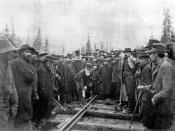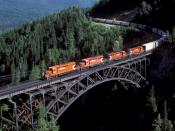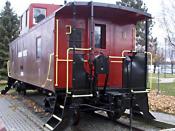The major factor of the linking of Canada was the Canadian Pacific Railway (CPR). The CPR began in 1880 and was completed in 1885. The significance of this railway was that it linked Montreal and central Canada to the west coast. Eastward, it linked Montreal with the Maritimes, which was part of MacDonald's National Policy. The USA took this development as a threat. The Canadian Pacific Railway is politically and economically important for developing the status of Canada.
There were extended negotiations between the supporters of MacDonald's National Policy, led by the owner the of Bank of Montreal, George Stephen, and the owner of the Hudson's Bay Company, Donald Smith who helped raise money in England. This group was under British Canadian control and the offers were reasonable. The CPR had 25 million acres of fertile western land, near to the rail line and also received 25 million dollars from the government.
The costs varied greatly from the original estimations and it became harder to raise capital. The last iron spike was hammered in by Donald Smith as the western moving team met with the eastern moving team from Port Moody.
In 1871, the Canadian government under MacDonald suggested building a railway from Central Canada to link the west and the east together. In 1873, the changed government banned MacDonald's contract for building the railway. Five years later, MacDonald came back to power and initiated a new association to build the railway. In 1880, a syndicate was arranged to start building the railway, until the CPR was making 10% of its invested capital. In 1885, the last spike was hammered (some reports say that it is gold and some say it is iron). Twelve years later, the freight rates were reduced because of the Crows Nest Pass Agreement.
There were numerous problems the consortium had to take into consideration while building this railway, such as the blasting of the preCambrian shield, north of Lake Superior. Also the Kicking Horse Pass in the Rockies presented problems because it was difficult to traverse. MacDonald also had to deal with the criticism the Liberal oppositions accused him of "Unmitigated profligacy"
Also in the process of building this railway, the Native Peoples were affected. It impacted them because many settlers were drawn to the treaties that effectively took away their land and interfered with their life style. The natives gave in without much resistance. The NWMP were used to keep watch over the newly opened areas in the western prairies, where they established a reputation for keeping disorder at a minimum. They also had the duty to keep American Whisky traders out of the prairies. The only serious local resistance to the opening up of the prairies came from Louis Riel and the Metis. They were quickly removed by the troops brought in by the CPR.
The British term for workman was Navvie. The CPR needed thousands of Navvies to help build the railway. Poor immigrants from all over the world, especially Irishmen, worked on the eastern side of Canada. These workmen lived in mobile tents, along the rail line. From the West, they recruited many Asian laborers at lower pay, and with inferior living conditions. Despite the way they treated them, they worked very hard in building the railway. There were European immigrant workers in the west as well, but they were segregated and had superior living conditions and a higher paying salary. Many Chinese workers were recruited overseas for work on the rail line. Later when the railway was finished, many of the workers would settle in Canadian towns rather than returning to their homelands.
The purpose of building the railway was to unify the nation and link the east to the west. Many of the lands were distributed to the settlers. The railway played a crucial role in the economic development because it opened new lands, which soon attracted thousands of new settlers. The western CPR terminus, originally in Port Moody, moved to the City of Vancouver, and Shaughnessy was developed by the leading management of the company, who built villas for themselves here.


